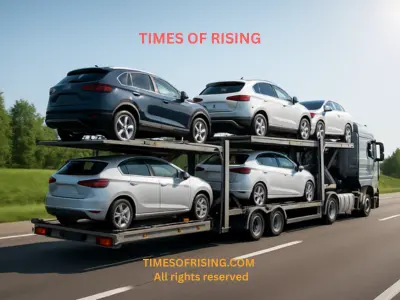The logistics industry is undergoing a massive transformation in 2025, and one of the biggest disruptors is auto transport services. From car shipping companies to vehicle relocation services, the auto transport sector is reshaping how goods and vehicles move across states, borders, and even continents.
This disruption is not just about convenience for individuals moving cars—it has wide-ranging implications for global supply chains, e-commerce growth, and high-value asset transportation.
This article explores how auto transport is evolving, why it is disrupting traditional logistics, and where the industry is heading.
The Rise of Auto Transport in Logistics
The traditional logistics industry primarily focused on freight shipping, container transport, and last-mile delivery. However, the surge in demand for vehicle logistics solutions has carved a new niche—auto transport logistics.
Auto transport refers to the professional movement of vehicles—ranging from personal cars, luxury vehicles, motorcycles, trucks, and SUVs—through specialised carriers. The rise of online auto marketplaces, increased relocation demands, ridesharing fleets, and global auto exports is fueling the industry at an unprecedented rate.
According to industry estimates, the global car shipping market is projected to hit over $150 billion by 2030, driven by rising consumer demand for efficient, safe, and cost-effective vehicle transportation solutions.
Why Auto Transport is Disrupting Supply Chains
1. Digital Transformation and Automation
Traditional logistics relied heavily on manual bookings, long transit schedules, and limited transparency. Auto transport companies, however, are adopting:
- AI-powered route optimisation to reduce costs.
- Real-time GPS tracking for vehicle shipments.
- Digital booking platforms that let customers compare car shipping quotes instantly.
- Blockchain solutions for transparent and secure auto logistics contracts.
2. High Demand from E-Commerce & Auto Sales
The boom in online car sales platforms (like Carvana, Vroom, and Tesla’s direct-to-consumer sales) has skyrocketed the need for reliable vehicle transportation. Every digital car purchase requires last-mile delivery logistics through an auto transporter.
3. Cross-Border Vehicle Relocation
The trend of global relocation by professionals and expatriates means cars are often shipped internationally. This disrupts traditional freight-only models by adding specialised services such as:
- Enclosed auto transport for luxury and classic cars.
- Overseas vehicle shipping via containers and roll-on/roll-off (RoRo) methods.
- Customs clearance and auto insurance integration through auto transport providers.
4. Reduced Dependency on Traditional Freight Models
Instead of relying on trucking companies or rail networks meant for goods, auto transport introduces dedicated carriers, reducing delays and improving efficiency. A standard 10-car haulier can move vehicles faster, cheaper, and with fewer risks than a traditional logistics chain.
How Car Shipping Companies Are Changing the Industry
- Door-to-Door Car Shipping: Eliminates the need for terminals, reducing customer hassle.
- Open vs Enclosed Carriers: Gives flexibility for budget-conscious shippers or owners of exotic cars.
- AI Scheduling: Matches demand with available carriers, reducing empty miles and carbon emissions.
- Fleet Relocation Services: Ride-hailing and rental companies use auto transport firms to rebalance fleets across regions.
This disruptive approach is transforming customer expectations—they now prefer digital-first auto transporters over traditional freight brokers.
Key Benefits of Auto Transport Logistics
- Cost Efficiency: With bulk shipments, per-car costs are lower than traditional truck logistics.
- Time Saving: Optimised transit schedules cut down waiting time for customers.
- Safety and Security: Enclosed shipping ensures safe delivery of high-value vehicles.
- Environmental Sustainability: Route optimisation results in reduced fuel consumption and emissions.
Challenges Facing Auto Transport
Despite its growth, the industry faces obstacles:
- Rising Fuel Prices: Increases transport costs, affecting shipping quotes.
- Driver Shortages: The trucking industry’s staffing issue spills over into auto hauling.
- Regulatory Hurdles: Cross-border customs and compliance create delays in international vehicle shipping.
- Insurance Costs: Premiums for luxury car shipping can be high.
Future of Auto Transport in Logistics
The next decade will see further disruption in logistics through advanced auto transport solutions:
- Electric Vehicle (EV) Shipping: Logistics providers are creating EV-specific shipping protocols.
- Autonomous Carriers: Self-driving trucks are expected to reduce labour shortages and improve safety.
- Green Transport Solutions: Carriers adopting renewable fuels and carbon-neutral shipping will gain a competitive advantage.
- On-Demand Car Shipping Apps: Much like Uber transformed ridesharing, apps could disrupt car transport by facilitating real-time bookings.
Final Thoughts
Auto transport is rapidly becoming a game-changer in the logistics industry. With its integration of AI, digital booking platforms, cross-border capabilities, and sustainability initiatives, it is clear that vehicle shipping logistics is not just an add-on—it is now a central pillar of the supply chain. Businesses, car dealers, and individuals all benefit from this disruptive model, making auto transport one of the most profitable and transformative sectors in modern logistics.
Frequently Asked Questions About Auto Transport
How much does car shipping cost?
The average cost to ship a car in the US ranges from approximately $0.40 to $2.00 per mile, with the total cost typically about $650 for an average shipment. Factors such as distance, vehicle type, carrier type (open vs enclosed), pickup and delivery locations, and seasonal demand influence the final price.
For example, open carrier transport tends to cost less, while enclosed carriers are about 25-40% more expensive due to added protection. In India, car shipping costs range from ₹5,000 to ₹45,000 depending on distance and vehicle type. Using an online car shipping quote calculator can help get precise cost estimates based on your specific needs.
Is enclosed auto transport worth it?
Yes, enclosed auto transport is highly recommended for luxury, classic, exotic, or high-value vehicles due to the superior protection it offers. Enclosed trailers shield vehicles from weather elements like rain, snow, and road debris, reduce the risk of damage or vandalism, and provide higher security and privacy.
Although 25-40% more expensive than open transport, the peace of mind and reduced risk of cosmetic or mechanical damage often justify the extra cost, especially for valuable or fragile vehicles.
What factors affect the cost of shipping a car?
Several key factors influence car shipping costs:
1. Distance: Longer distances increase overall cost but reduce cost per mile.
2. Vehicle Size and Weight: Larger and heavier vehicles cost more due to space and fuel consumption.
3. Type of Transport: Open carriers are cheaper; enclosed carriers cost more.
4. Vehicle Condition: Non-operational vehicles may require special loading equipment, increasing costs.
5. Location: Remote or less-travelled routes typically cost more due to a lack of backhaul opportunities.
6. Season: Peak moving seasons may increase prices due to higher demand.
How do I track my vehicle during transport?
Most modern auto transport companies offer GPS tracking services that allow customers to monitor their vehicle’s location in real-time during transit. Customers can also contact the driver directly or the carrier’s dispatch agent for status updates. GPS tracking provides transparency and peace of mind throughout the shipping process.
What is door-to-door car shipping?
Door-to-door car shipping allows vehicle pickup and delivery directly from and to the customer’s specified address, saving time and hassle. While trucks cannot always access every residential street, carriers strive to deliver vehicles as close as possible to the requested location. This service is more convenient than terminal-to-terminal shipping and is increasingly popular among consumers.







